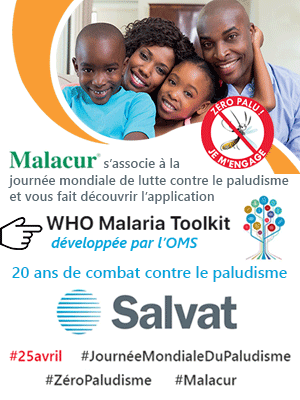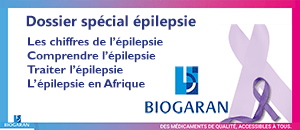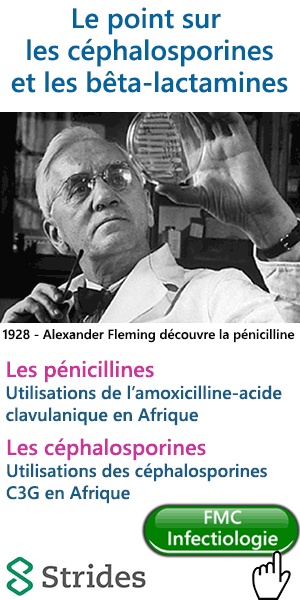Accès aux sites pays ![]()
![]() BENIN
BENIN![]() BURKINA FASO
BURKINA FASO![]() CAMEROUN
CAMEROUN![]() CENTRAFRIQUE
CENTRAFRIQUE![]() CONGO
CONGO![]() COTE D'IVOIRE
COTE D'IVOIRE![]() GABON
GABON
![]() GUINEE
GUINEE![]() MADAGASCAR
MADAGASCAR![]() MALI
MALI![]() R.D. CONGO
R.D. CONGO![]() SENEGAL
SENEGAL![]() TOGO
TOGO
Accès aux sites pays ![]()
![]() BENIN
BENIN![]() BURKINA FASO
BURKINA FASO![]() CAMEROUN
CAMEROUN![]() CENTRAFRIQUE
CENTRAFRIQUE![]() CONGO
CONGO![]() COTE D'IVOIRE
COTE D'IVOIRE![]() GABON
GABON
![]() GUINEE
GUINEE![]() MADAGASCAR
MADAGASCAR![]() MALI
MALI![]() R.D. CONGO
R.D. CONGO![]() SENEGAL
SENEGAL![]() TOGO
TOGO

Publié dans Médecine d'Afrique Noire 6607 - Juillet 2019 - pages 370-378
 Particularités de prise en charge chirurgicale des goitres pluri-nodulaires bénins à l’Hôpital d'Instruction des Armées de Cotonou, Bénin
Particularités de prise en charge chirurgicale des goitres pluri-nodulaires bénins à l’Hôpital d'Instruction des Armées de Cotonou, BéninAuteurs : A. Do Santos Zounon, G. Attolou, U. Vodouhe, W. Adjibabi, B. Vignikin-Yehouessi, C. Page - Bénin
Introduction : Le goitre "bénin" est une hypertrophie diffuse de la thyroïde normo-fonctionnelle, non-inflammatoire et non-cancéreuse. Le but de la présente étude était d’analyser les particularités de prise en charge des goitres pluri-nodulaires relevant d’une indication chirurgicale.
Matériel et méthode : Cette étude de cohorte rétrospective a été réalisée du 1er janvier 2013 au 1er janvier 2018 à l’Hôpital d’Instruction des Armées - Centre Hospitalier Universitaire de Cotonou, Bénin. Ont été inclus les patients opérés pour goitre pluri nodulaire bénin. Ont été exclus les patients atteints de pathologies thyroïdiennes non nodulaires ou de cancer thyroïdien. Les données étudiées ont été : l’âge, le sexe, la profession, le lieu de résidence, le motif de consultation, les signes cliniques, les signes échographiques, la prise en charge chirurgicale, les complications per et post-opératoires et l’histologie définitive de la pièce d’exérèse. Ces données ont été colligées à l'aide du logiciel Excel 2016.
Résultats : Pendant la période d’étude 2,46% des consultations ORL ont bénéficié d’une prise en charge chirurgicale pour goitre pluri-nodulaire bénin (19 cas/an) : 71 femmes (72,45%) et 27 hommes (27,55%), moyenne d’âge de 36 ans (17 à 44 ans). D’un point de vue socio-économique : 50 patients exerçaient une profession libérale et 35 patients étaient sans emploi fixe. Les motifs de consultation étaient une masse cervicale (67 patients), des signes d’hyperthyroïdie (20 patients) ou des signes de compression de l’axe viscéral du cou (11 patients). La durée moyenne avant consultation ORL était de 7,62 ans (1 à 18 ans). L’examen clinique avait objectivé une glande thyroïde "ferme" (70 patients ; 71,4%) pluri-nodulaire (76 patients ; 77,55%) sans adénopathie cervicale palpable (100%). Deux tiers des patients avaient un goitre de grade 3 de l’OMS. Les gestes chirurgicaux étaient une thyroïdectomie subtotale (52 ; 53,1%), une thyroïdectomie totale (30 patients ; 30,6%) et une lobectomie unilatérale avec isthmectomie (16 patients ; 16,3%). L'examen anatomo-pathologique a été réalisé pour toutes les pièces de thyroïdectomie objectivant un goitre macro-folliculaire chez 51 patients (52,04%). Aucun cas de décès n'a été enregistré. Les suites opératoires ont été marquées par un taux de paralysie récurrentielle de 2,78 % en termes de nerf à risque ainsi qu’une reprise chirurgicale pour drainage d’hématome compressif (2,04%).
Conclusion : Le traitement de choix du goitre pluri-nodulaire bénin est théoriquement la thyroïdectomie totale. Cependant, le recours à une l’opothérapie et la nécessité d’un long suivi post-opératoire limite ses indications chez les patients de niveau socio-économique défavorable. Les techniques chirurgicales de thyroïdectomies partielles ou subtotales gardent tout leur intérêt dans ces indications.
Introduction: "Benign goiter" is a non-inflammatory and non-cancerous diffuse hypertrophy of a normally functioning thyroid. The purpose of the present study was to analyze the peculiarities of surgically managed multinodular goiter.
Material and method: This retrospective cohort study was conducted from January 1st, 2013 to January 1st, 2018 at the Army’s Teaching Hospital, (HIA-UTH) of Cotonou, Benin. Patients operated on for benign multinodular goiter were all included. Patients with non-nodular thyroid conditions or thyroid cancer have been excluded. The studied data were: age, sex, occupation, place of residence, reason for consultation, clinical signs, ultrasound signs, surgical management, per and postoperative complications, and definitive histology results of the surgical piece’s analysis. This data was collected using the Excel 2016 software.
Results: During the study period, 2.46% of ENT consultations was received surgical treatment for benign multinodular goiter (19 cases/year): 71 women (72.45%) and 27 men (27.55%), average age 36 (17 to 44 years). From a socio-economic standpoint: 50 patients practiced a liberal profession and 35 patients didn’t have a stable profession. The reasons for consultation were a cervical mass (67 patients), signs of hyperthyroidism (20 patients) or signs of compression of the visceral axis of the neck (11 patients). The mean duration before ENT consultation was 7.62 years (1 to 18 years). Clinical examination showed a "firm" thyroid gland (70 patients, 71.4%) multinodular (76 patients, 77.55%) without palpable cervical lymphadenopathy (100%). Two-thirds of the patients had a WHO grade 3 goiter. Surgical procedures included subtotal thyroidectomy (52 patients, 53.1%), total thyroidectomy (30 patients, 30.6%) and unilateral lobectomy with isthmectomy (16 patients, 16.3%). Anatomo-pathological examination was performed for all thyroidectomy surgical piece demonstrating a macro-follicular goiter in 51 patients (52.04%). No cases of death have been recorded. The follow up was marked by a recurrence rate of 2.78% in terms of risky nerve and surgical revision for drainage of compressional hematoma (2.04%).
Conclusion: The treatment of choice for benign multinodular goiter is theoretically total thyroidectomy. However, the use of opotherapy and the need for a long postoperative follow-up limits its indications for patients of low socioeconomic status. The surgical techniques of partial or subtotal thyroidectomy remain of interest in these cases.
Cet article est actuellement coté ![]() (1,0 étoiles) par les abonnés de Médecine d'Afrique Noire.
(1,0 étoiles) par les abonnés de Médecine d'Afrique Noire.
Il a été consulté 4984 fois, téléchargé 9 fois et évalué 1 fois.
Aucun commentaire n'a encore été ajouté à propos de cet article
 Obtenir l'article intégral en PDF
Obtenir l'article intégral en PDF
Plus de résumés d'articles - Plus d'articles en texte intégral
Restez informés : recevez, chaque mercredi, la lettre d'informations de Santé tropicale. Inscriptions
Ce contenu gratuit vous est destiné :







![]() Adresse
Adresse
![]() Téléphone
Téléphone
![]() Contactez-nous
Contactez-nous
Actualités
Articles médicaux